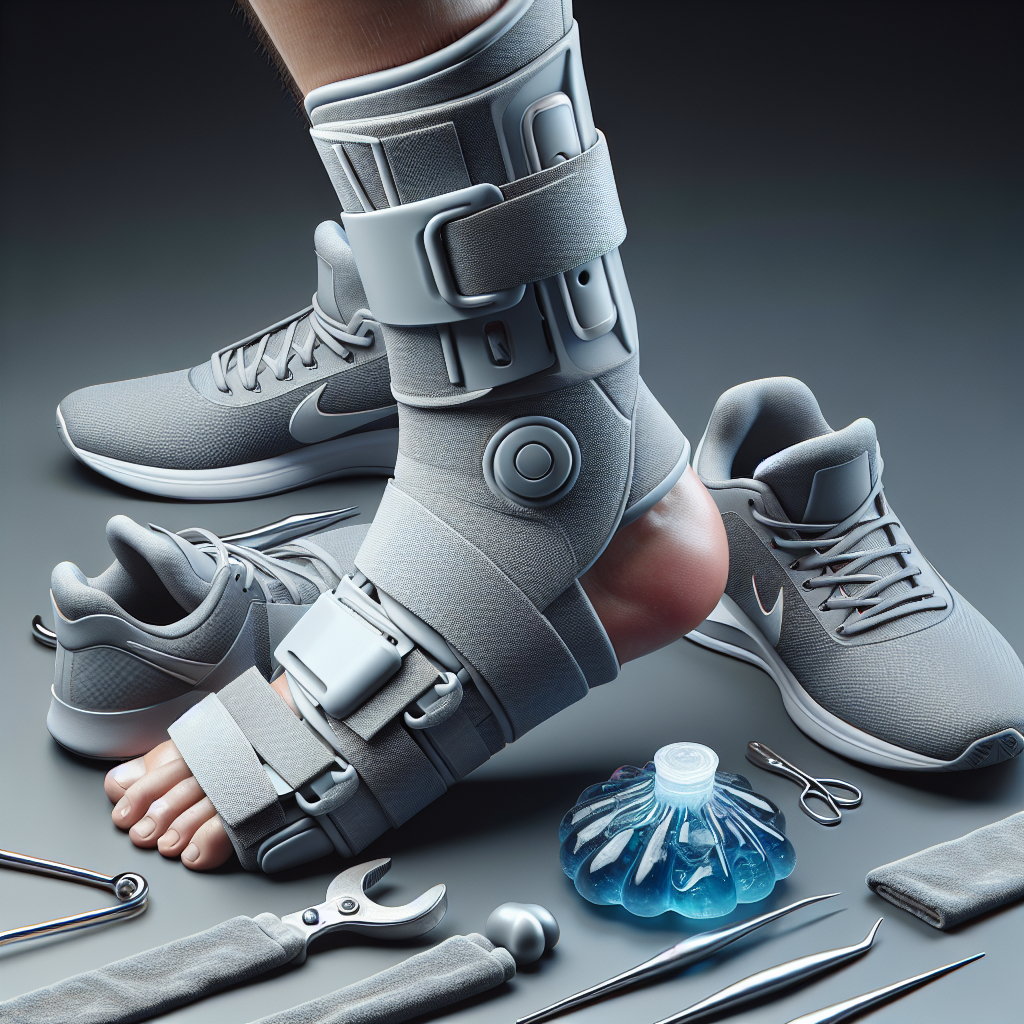
Handling Ankle Sprains Fractures And Tendon Tears With Orthopedic Injury Doctor Houston
Ankle injuries often disrupt normal routines and impact sports performance significantly. An orthopedic specialist plays a key role in diagnosing issues related to this area.
When assessing sprains, fractures, and tendon repair, they evaluate the severity of the condition.
Effective fracture care frequently necessitates imaging studies to identify the specific type of injury.
Timely intervention is important for optimal recovery, which may include methods like rest, ice, compression, and elevation, alongside professional guidance. Sprain management is particularly crucial for athletes and active individuals, as customized rehabilitation plans can greatly enhance recovery and restore mobility.
The expertise of an orthopedic injury doctor, especially one located in Houston, ensures comprehensive care for those navigating these injuries.
Click here to learn more about: orthopedic injury treatment.html
Understanding Ankle Anatomy And Injuries
The complexity of the ankle joint plays a significant role in facilitating movement and providing stability. Comprising various bones, ligaments, and muscles, its proper function is paramount for daily activities.
Injuries, particularly sprains and fractures, frequently result from high-impact sports or the use of improper footwear.
Joint instability may present as pain and swelling, often hindering one’s ability to walk comfortably.
Acknowledging the early signs of injury is vital for rehabilitation efforts. Applying conservative treatment methods, such as the RICE method, can greatly enhance recovery efficiency.
Consulting with an Orthopedic Injury Doctor in Houston is crucial for effective management and better recovery strategies.

What Is Sprain Management Strategy
Recognizing an injury promptly is the first step in addressing a sprain effectively. When ligaments are stretched or torn due to sudden movements, immediate care strategies become paramount.
Sprains are particularly common in sports, often resulting in significant discomfort.
The initial treatment frequently involves the R. I. C. E.
Method—Rest, Ice, Compression, and Elevation—which plays a significant role in managing symptoms. Following this immediate response, evaluation by an orthopedic injury doctor in Houston is important, especially to determine if imaging studies are necessary to rule out ligament tears.
Rehabilitation then focuses on pain management and restoring mobility to ensure a full recovery. As one transitions from managing sprains, understanding effective fracture care techniques becomes essential for overall injury management.
Sprain Management
- Approximately 25,000 sprains occur in the United States each day, highlighting their prevalence, especially in sports.
- The R. I. C. E. method is widely recommended by healthcare professionals as an effective initial treatment for sprains.
- Prompt evaluation by an orthopedic doctor can help prevent complications and ensure proper treatment, including the need for imaging studies.
- Effective rehabilitation can significantly reduce recovery time and improve mobility after a sprain.
Effective Fracture Care Techniques
Managing fractures requires a clear approach to ensure optimal recovery. Immediate response to injuries involves proper stabilization and immobilization to promote swelling reduction and minimize further damage.
Identifying key symptoms like pain and inflammation is crucial for timely intervention.
After addressing initial care, establishing a comprehensive recovery plan becomes necessary.
This plan typically includes following rehabilitation guidelines, particularly those involving mobility exercises to help restore function and reduce the risk of re-injury. An orthopedic evaluation is recommended to gain insights into personalized treatment strategies tailored to individual needs, especially when consulting with an orthopedic injury doctor in Houston.
Importance Of An Orthopedic Specialist
Receiving specialized care for musculoskeletal issues can greatly enhance recovery and overall health. With their extensive training, these professionals focus on accurate injury assessment, enabling them to determine the best course of action for each patient.
They devise tailored treatment plans that address specific needs, incorporating various methods, including options for strength training and rehabilitation.
Each approach, whether surgical or non-surgical, is designed to ensure the best possible results.
Patients benefit from thorough guidance throughout their recovery journeys, particularly when dealing with tendon inflammation or other related conditions. Selecting an orthopedic injury doctor in Houston can make a significant difference, as their experience and expertise lead to effective management of injuries, paving the way to recovery and better health.
| Key Benefits of Specialized Care | Importance of Tailored Treatment Plans |
|---|---|
| Enhanced recovery and overall health | Addresses specific needs of each patient |
| Accurate injury assessment by trained professionals | Incorporates various methods, including strength training |
| Effective management of injuries | Guidance through recovery journeys for tendon inflammation |
How To Reduce Swelling After Injury
Managing inflammation effectively after an injury can significantly influence your recovery journey. To address this response, apply the R. I. C. E.
Method: Rest, Ice, Compression, and Elevation.
It’s important to limit movement to prevent aggravation of athletic injuries.
For ongoing recovery, consider discussing anti-inflammatory medications with an orthopedic surgeon, as they can provide tailored recommendations. Engaging in physical therapy can aid in restoring joint function and overall mobility.
These proactive steps are instrumental in facilitating a smoother healing process, allowing for a quicker return to your normal activities.
Role Of Imaging Studies In Diagnosis
Accurate diagnosis of orthopedic conditions relies heavily on various imaging techniques.
These methods, including X-rays, MRIs, and CT scans, reveal specific injuries in the body.
For instance, when evaluating a case involving ankle surgery, imaging can pinpoint fractures not detectable during physical assessments.
This vital information allows specialists to establish appropriate immobilization strategies, ensuring the best possible recovery trajectory.
Imaging studies aid in determining whether a cortisone injection or ankle arthroscopy is warranted.
Engaging with an orthopedic injury doctor in Houston can further enhance treatment planning and patient outcomes.
The insights gained from these studies contribute significantly to effective physical rehabilitation
Orthopedic Imaging Techniques
- X-rays, MRIs, and CT scans are essential for identifying specific injuries in orthopedic conditions.
- Imaging can reveal fractures that may not be visible during physical examinations.
- Imaging studies assist in determining the need for interventions like cortisone injections or surgical procedures.
- Consulting with an orthopedic injury specialist can improve treatment planning and enhance recovery outcomes.
Exploring Conservative Treatment Options
Effective management of orthopedic injuries often relies on a holistic approach. Initial management frequently incorporates the RICE technique, promoting recovery time and reducing inflammation.
Subsequently, tailored stretching exercises through physical therapy can significantly enhance recovery by improving strength and flexibility.
These non-invasive strategies aim to restore function while mitigating the risks associated with surgical interventions.
Consulting with an orthopedic injury doctor in Houston can ensure personalized care, leading to an optimal postinjury care strategy. By concentrating on these methods, patients can expect to achieve improved long-term results and return to their daily activities more swiftly.
Transitioning from the role of imaging studies in diagnosis, it’s essential to recognize the benefits of rehabilitation and recovery plans, which further enhance the overall treatment journey.
Benefits Of Rehabilitation And Recovery Plans
Effective planning and support play a significant role in the healing journey following an injury. These structured pathways cater to personal needs, ensuring thorough care post-injury.
Strong focus on injury prevention through tailored programs tackles specific weaknesses while reinforcing strength.
Collaborating with a specialized healthcare team, such as an Orthopedic Injury Doctor in Houston, enhances the recovery experience, offering necessary guidance throughout the process.
Regular consultations facilitate monitoring of progress, allowing for adaptations to the plan as circumstances evolve. Such proactive measures not only promote a faster recovery but also mitigate the potential for future injuries.
Comprehensive strategies enhance lasting health and well-being, seamlessly transitioning toward the next vital aspect of recovery: the importance of strength training.
| Aspect of Recovery | Importance |
|---|---|
| Effective Planning | Ensures thorough care post-injury |
| Injury Prevention Programs | Tackles specific weaknesses and reinforces strength |
| Collaboration with Healthcare Team | Enhances recovery experience and provides guidance |
| Regular Consultations | Facilitates progress monitoring and plan adaptations |
Why Is Strength Training Essential For Recovery
Recovering from orthopedic injuries requires a multifaceted approach, with an emphasis on proper techniques to regain function. Engaging in resistance exercises fosters improved stability around affected areas, significantly minimizing the likelihood of further harm.
Those recovering can enhance their movement patterns through targeted training, which also aids in promoting blood flow—important for repairing injured tissues.
A personalized program that focuses on increasing weightbearing capabilities is crucial for effective rehabilitation.
This not only facilitates a faster recovery but also helps individuals regain confidence as they transition back to their daily routines. Consulting with an Orthopedic Injury Doctor in Houston can provide further insights into optimizing recovery through structured strength programs.
When Is Surgical Intervention Necessary
Assessing the situation surrounding orthopedic injuries can significantly influence recovery strategies. Soft tissue injury management plays a pivotal role in determining the best course of action.
Timely intervention can prevent complications that worsen conditions.
A consultation with an orthopedic injury doctor in Houston is important for accurate diagnosis and tailored treatments.
Some injuries may necessitate surgical solutions, particularly when conservative approaches fail. Common signs suggesting the need for surgery include persistent pain, swelling, or loss of function, which can hinder joint relief.
Understanding the risks associated with delaying treatment can inform better decisions. Implementing functional rehabilitation and muscle strengthening exercises after surgery is key for improved recovery results.
| Key Factors | Details |
|---|---|
| Importance of Timely Intervention | Prevents complications that can worsen conditions |
| Signs Indicating Surgery | Persistent pain, swelling, or loss of function |
| Role of Rehabilitation | Functional rehabilitation and muscle strengthening enhance recovery |
| Consultation Necessity | Accurate diagnosis and tailored treatment by an orthopedic specialist |
Caring For Muscle Strains Joint Sprains And Tendonitis With Orthopedic Injury Doctor Houston
